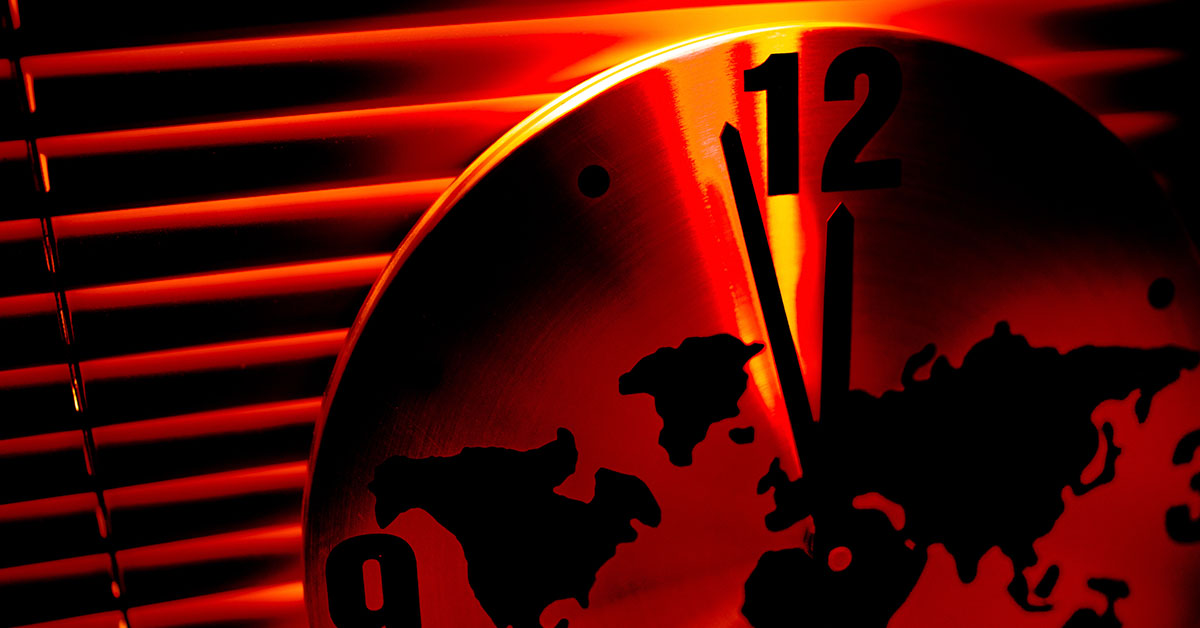The world inches closer and closer to disaster – according to the Doomsday Clock. Now resting at a mere 90 seconds away from midnight, a myriad of factors are responsible but this is the closest to midnight the world has ever been (and has been since January of last year). The clock was established in 1947 by a group of atomic scientists, including the likes of Albert Einstein. The Doomsday Clock is meant to be a chilling reminder of the existential threats facing our planet, with each tick marking an ever-diminishing margin for error.1
The Doomsday Clock
When it was first created, the Doomsday Clock primarily warned against the dangers of nuclear war. But now, its mandate has evolved to cover a broader spectrum of man-made perils, including climate change, geopolitical tensions, and emerging technologies. Rachel Bronson, president of the Bulletin of the Atomic Scientists, commented on the gravity of the situation, stating, “[m]ake no mistake…setting the Clock at 90 seconds to midnight is not an indication that the world is stable. Quite the opposite”.
The recent escalating conflicts in the Ukraine and the Middle East have only made global anxieties worse about the potential of nuclear warfare. Russia’s invasion in particular has reignited fears of a nuclear apocalypse, with thinly veiled threats of nuclear weapon deployment by Vladimir Putin only heightening tensions. Bronson warns that the conflict’s repercussions extend beyond the immediate threat of nuclear war, undermining global efforts to combat climate change.
Additionally, the Bulletin of the Atomic Scientists identified the rapid advancement of artificial intelligence (AI) as another major contributor to the heightened risk of a global catastrophe. The rise of sophisticated AI technologies, including chatbots and autonomous weapons systems, raises concerns about any unintended consequences and the democratic institutions being dealt away with.
Jerry Brown, former California governor, emphasizes the urgent need for international cooperation when it comes to AI governance: “Leaders are steering the world toward catastrophe — more nuclear bombs, vast carbon emissions, dangerous pathogens, and artificial intelligence”.2 Some disagreements are clear to see, but in the end, we will have to work together to make the world a safer (in theory and practice) place for everyone.
There’s Still Hope
Amidst the mounting threats, the Bulletin acknowledges the importance of global leadership in averting disaster. Renowned science educator Bill Nye is amongst such leaders, and when asked about the Doomsday Clock he commented, “[f]or decades, scientists have been warning us of the dangers facing humankind. We could be facing catastrophe unless we better manage the technologies we’ve created.” Despite criticisms of the Doomsday Clock as a measure of actual risk, the Bulletin maintains that its significance lies in its ability to call attention to and raise awareness of the urgency of addressing existential threats.
As the clock ticks closer to midnight, hope remains that collective efforts from the international community can lower the risks and steer humanity away from the edge we’re currently on. That said, the time for decisive action is now, as the fate of future generations hangs in the balance.
The Bulletin cites the climate crisis as a central driver behind the advancement of the Doomsday Clock. The Earth’s hottest year on record in 2023, coupled with devastating floods, wildfires, and extreme weather events. Climate action has never been needed more than it is right now. These disasters are becoming less and less natural, and they pose immediate threats to human life and are agitating socio-political tensions, potentially fueling further conflict.
Speaking of which, the deterioration of ongoing geopolitical conflicts is not much better than the climate crisis. Nuclear arms reduction agreements are falling through, and geopolitical conflicts like the Israel-Gaza genocide, are only making things worse. The genocide has already claimed tens of thousands of lives and threatens to escalate regional tensions further.
Tick Tock, Doomsday Clock
Artificial intelligence’s emergence is a double-edged sword in the context of global security. While AI holds immense promise for addressing pressing societal challenges like disease prevention and resource management, it has gone mainly unchecked thus far, and that poses significant risks. The Bulletin warns of the potential for AI to amplify the use of misinformation and undermine democratic institutions, only making societal divisions worse and eroding what little trust is left in public institutions.
Even with the sobering news from the Doomsday Clock, the Bulletin remains hopeful that humanity can and will avoid catastrophe. Bill Nye asserted, “[o]nly the big powers like China, America, and Russia can pull us back. Despite deep antagonisms, they must cooperate — or we are doomed”. In the face of mounting global threats, global leaders need to rise above political divisions and prioritize collective well-being over short-term interests.
With a minute and a half to go before midnight, there is still a window of opportunity for humanity to move towards a safer and more sustainable future. By heeding the warnings of the Doomsday Clock and embracing collaborative solutions, we can strive to avoid global catastrophe and safeguard the well-being of future generations.
Read More: Upcoming Solar Eclipse Could Lead to Over 1,000 Car Crash Deaths, Study Warns
Sources
- “Doomsday Clock Is Closest It’s Ever Been To Armageddon In 2024 Update.” IGV Official. Annie Walton Doyle. January 23, 2024.
- “Doomsday Clock at 90 seconds to midnight amid nuclear and AI threats.” Washington Post. Adela Suliman. January 24, 2024.

